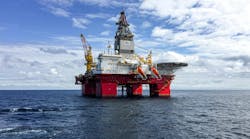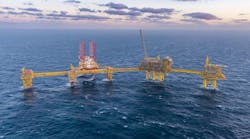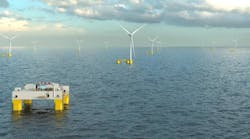The application of a pressurized riser system, including limited surface cont-ainment devices, has been incorporated into the design of R&B Falcon's Deepwater Nautilus. A gas handler riser system provides an alternate to the conventional floating rig diverter system for handling gas that gets past the blowout preventer (BOP) stack.
The gas handling system reduces the volume of mud displaced (lost) from the riser. This is accomplished by keeping the gas pressure significantly higher than atmospheric pressure. This system is sized to operate at a maximum pressure of 1,500 psi. The flow sizing is nominally sized for 1,400 psi to allow some pressure fluctuations while controlling the flow with the dedicated gas handler choke. The nominal volume difference is almost 100:1 for the gas between one atmosphere and 1,400 psi.
The riser system provides safer handling of gas that has passed the BOP stack. Gas in this case is limited to detectable amounts, not unlimited amounts. While kick detection methods are continually improving, the flip side is that new kick detection systems are trying to detect a 15-20 bbl gain in a 6,000 bbl system, instead of a 1,500 bbl system.
Larger volumes
Using a gas handling system larger amounts of gas in the riser can be handled safely for a longer period of time, then diverted overboard. The mud loss is greatly reduced compared to simply diverting riser flow overboard.
Reverse circulation of the riser is another alternative, but the tactic of reverse circulation of the riser back up a choke/kill line, forcing the gas in the riser back to the normal choke manifold, is not considered a reliable technique. There is a danger that the kick gas could be channeled up the riser faster than the mud could be circulated down the 19-in. bore riser. The density of methane at these pressures is around 2 ppg or less at the rated depth for the system.
Because there is no built-in safety valve on the riser, a gas event in the riser is handled much like a well kick. The difference is the well below the BOP stack normally has a casing shoe "safety valve." If too much gas gets past the stack and into the riser, it must be vented. The capacity of the gas handling system is a function both of pressure capability and of venting capacity.
For this reason, the Deepwater Nautilus was fitted with two riser choke lines, and annular packers capable of being opened under full rated pressure. The overriding concern is to be able to relieve the pressure from a migrating bubble rather than pressure containment, as it is known that the potential pressure in the riser from a rising bubble can be several times the pressure capability of the riser.
Using this equipment, more of the liquid mud is retained in the system, making it easier, safer, faster, and less expensive to restore hydrostatic balance at the end of well control events.
Equipment required
To incorporate the gas handler system, the riser walls must be slightly heavier and stronger couplings are required. The pressure increase for this system was an additional 1,000-psi, increasing the 500 psi diverter pressure allowance to 1,500 psi for the gas handler system. The gas handler, being closed in at the top of the riser adds about 500 kips (1kip = 1,000 lb) of axial tension when pressured to 1,500 psi.
Buoyancy requirement is increased slightly. Buoyancy dry weight was increased by about 200 kips. Also the lower flex joint (lower marine riser package or LMRP) needs to be able to handle additional pressure and the tension from that pressure. A separate low-pressure choke manifold is required. A self-regulating choke is recommend for this, because of the very rapid flow changes required.
A gas handler also is required. This is essentially an annular preventor below the telescoping joint. The unit supplied by Hydril to the R&B Falcon Deepwater Nautilus was a dual packer unit for increased reliability through redundancy.
Current designs require choke, kill, hydraulic power, mud boost, and riser choke lines to terminate below the gas handler element, if handling through a 60-in. rotary. The Nautilus system had two riser choke lines for redundancy. Performance might potentially be improved through higher flow capacity with two lines. The supplied system was sized for operation with a single line functioning. A control system for the gas handler equipment is added to the BOP/Diverter control system.
Slightly more riser tension is required, mostly because of the weight of the gas handler joint and equipment in the riser string, and because of the increased mass of the riser.
The gas handler concept is not currently addressed in rules and regulations. In developing this system, the path taken was to consider the gas handler as an optional piece of surface equipment. The existing diverter system remains in place, and fully functional if needed. Although the unit is under the surface of the water when installed, it is placed just below the telescopic joint. This was part of the reason for providing two packing units and two riser choke line outlets. The redundancy covers the potential failure of any particular part of the system without "dual pods."
For a 9,000-ft. design, the riser, buoyancy, and topside equipment add about 600-800 kip to the rig. The additional cost is in the range of $1.5-2.5 million, depending on options.
Equipment operation
The heart of the sizing of the gas handler system equipment is derived from a paper by Johnson et al (IADC/SPE 29342, 1995) documenting the high rate of speed (350 ft/min) large gas bubbles travel up a riser, and how much of the bubble is left behind, strung out along the length of the riser. The basic equipment arrangement was proposed in a paper by Hall et al, (IADC/SPE 14739, 1986).
This is new equipment and a new technique; there is still much to be learned from the initial use of this equipment. More techniques will be learned in actual field experiences as more people are exposed to the equipment and procedures.
When a well kick is detected, the BOP stack is closed in. Mud boost is stopped. The riser is then closed in with the gas handler, monitoring the riser pressure through the riser choke line(s) and riser pressure monitor. The well kill is handled as two separate events.
There is one well kill above the BOP stack in the riser, and the second, more conventional, well kill below the BOP stack. The idea is to handle the kick below the BOP stack first, as it is the source of difficulty. If the conditions are otherwise favorable, no gas will escape past the BOP stack prior to closing the well in. Such a well would be killed conventionally, and then the riser displaced with kill-weight mud at the end of the well kill.
If there is sufficient gas past the BOP stack, this gas could migrate at ascent rates in the range of 350 ft /min. toward the surface. Design limit events for the gas handler will develop very quickly. At a migration rate of 350 ft/min, a gas bubble at 9,000 ft would surface in about 25 minutes. Pressure would be registered almost immediately, about five minutes from closing the gas handler packer.
If the riser indicates a bubble rising, circulation of the primary well is temporarily stopped (if it has started) while the riser kick is handled. One kick is handled at a time; it is not perceived as good practice at this juncture to force two well kill circulations simultaneously.
Bubble entrainment
As this gas migrates toward the surface, some of the gas bubble (0.5-5.0% volume fraction of the mud) may become entrained along the length of the riser. The mud properties that allow the bubble to string out and become static have a huge effect on the allowable bubble size. This void fraction at 0% allows for a maximum bubble of about 15 bbl, 0.5% allows for a 26 bbl bubble, and 5% allows for a 120 bbl bubble.
These rates assume other factors are similar, with a 400 ft/min rise rate in a 9,000-ft riser and 15-ppg mud. A zero retained void fraction was used as a worst case bracket, considering that the riser may already be filled with gas cut mud prior to taking a kick.
As the bubble migrates upward, it will increase the riser pressure unless the bubble is allowed to expand. For the design case described here, a 9,000-ft. deep riser full of 15-ppg mud has a "bottom hole pressure" of about 7,030 psi. The riser cannot withstand the full brunt of this pressure rise, so the pressure is bled through a choke line exiting the riser just below the gas handler annular element, located just below the slip joint. The riser design for this system is 1,500 psi above mud to seawater gradient. The intent is to keep the pressure rise near 1,400 psi, without exceeding 1,400 psi. A choke operator monitors the riser pressure continuously while the riser is closed in, and adjusts the choke accordingly.
By discharging very small amounts of mud from the top of the riser, the pressure can be controlled until the gas nears the surface. For the first 12 minutes, rising from 9,000 ft to 4,500 ft, the bubble only doubles in size, say from 15 bbl to 30 bbl. The design sizing for the system is based on a maximum 700-gpm mud flow. The system in-stalled on the Deepwater Nautilus is fitted with two chokes and lines for redundancy and may possibly handle more than 700 gpm with both chokes combined. Note that for the example situation presented the mud flow at the riser choke doubles in the last two minutes as the bubble surfaces.
The higher the pressure can be maintained in the riser, the smaller the actual gas volume is to discharge, and smaller mud displacements are actualized. In fact, the bubble may never actually surface during this phase. If the gas is completely strung out in the riser, it may become relatively stable, and not surface until the riser is circulated after the primary well kill. Any gas retained in the mud is easily handled in the mud gas separator, and all of the mud is recovered in the riser circulation though the mud/gas separator.
If the riser choke lines cannot keep the pressure below 1,500 psi in the riser, the fall back position is to open the gas handler and divert the remaining flow over the diverter lines. Although the system was sized so that all of a detectable kick should be safely handled in the riser, it is anticipated that at least some of a detectable kick would be captured below the BOP stack. Normal expectation is that all of the kick would be below the BOP stack; this system is an additional safety barrier for unexpected events.
Once the gas bubble surfaces and the gas pressure is vented, the riser can be filled with mud again through the mud boost line. Normal well control procedures would resume (kill the well, then circulate the riser with kill weight mud, circulating the riser mud through the mud gas separator).
Riser analysis
It is fairly straight forward to compare the pressure and tension requirements of this system in global analysis. The effects of line load sharing are somewhat reduced with the heavier riser, because the auxiliary lines make up a slightly smaller percentage of the steel in the riser, and the heavier riser tube is slightly stiffer. A line load sharing analysis should be done in any event, but to make exact wall thickness comparisons for the gas handler, versus a diverter, requires much detail and will not work out to exactly the same stress levels everywhere in the riser.
At the design pressure of 1,500 psi added surface pressure, the tension developed in the riser from the closed-in gas handler adds about 500 kips of tension to the separating loads on the riser main tube couplings. The good news is that this pressure does not reduce the effective tension in the riser as the open-ended diverter would, so no compensation for tension is required.
This undesirable effect is not normally a problem with the 500 psi diverter riser system, because the lower pressure and the normal excess tension applied for loss of a tensioner contingency is more than adequate to prevent tension problems in the riser if a diverter event is experienced. The riser analysis comparison allowed a reduction of 500 lb-meters/riser joint for the reduced coupling requirement weight reduction. Coupling weight impact was minimized by the use of 90-ft riser joints.
The sample riser system used to compare the diverter riser to the gas handler riser did not use riser collapse as part of the tube sizing criteria; the rig is moored, and the perceived risk, versus cost, was considered to favor ignoring the collapse from voiding the riser, particularly considering the added features of the gas handler in avoiding some of the major potential voiding hazards.
If voiding the riser is used as part of the main tube sizing criteria, then the weight differences between the two systems gets much smaller, as the tube will be sized for collapse as a governing criteria. Because of the already thicker main tube, the gas handler system is more collapse resistant, and is collapse resistant for most u-tube disconnect potentialities.
References
The papers referenced in this article are: Hall, et. al., Means for Handling Gas Influx in a Marine Riser, IADC/SPE 14739, 1986; Johnson, et. al., Gas Migration: Fast, Slow, or Stopped, IADC/SPE 29342, 1995.
Author
Robert Taylor has been involved in well control equipment, maintenance and operations since 1976. He is currently Manager, Technical Services at Marine Drilling Companies (Sugar Land, Texas). He holds a BS in mechanical engineering from Texas A&M.






